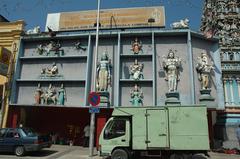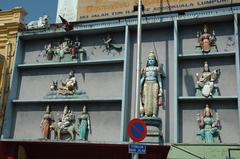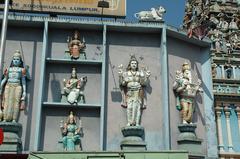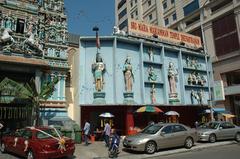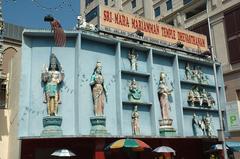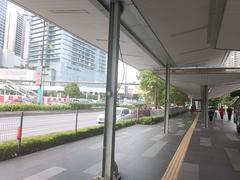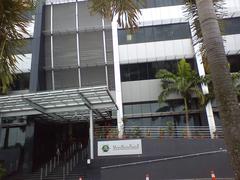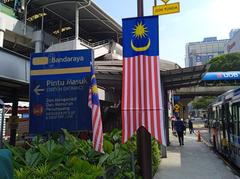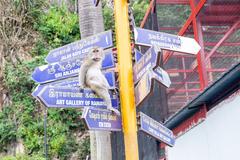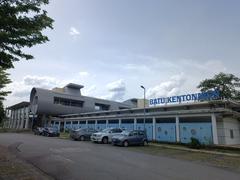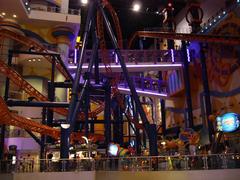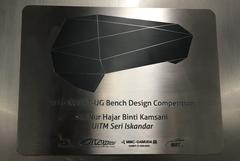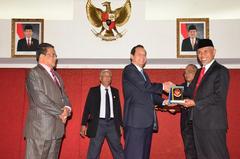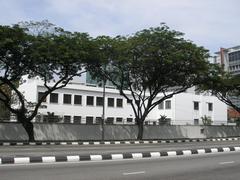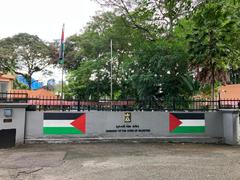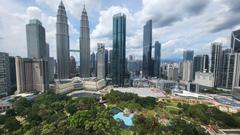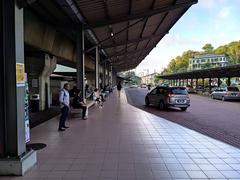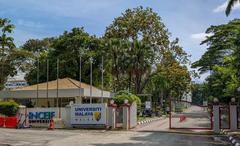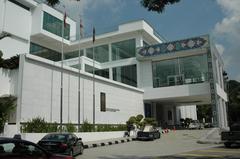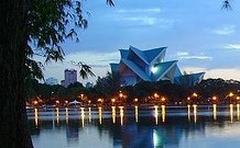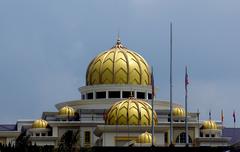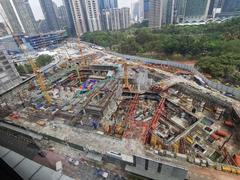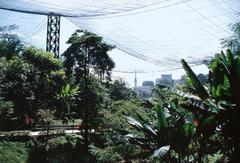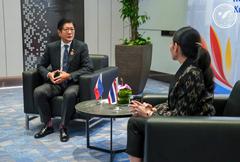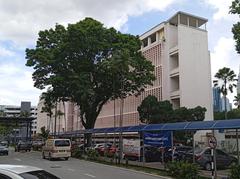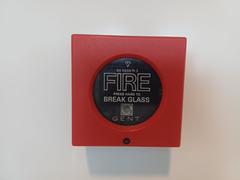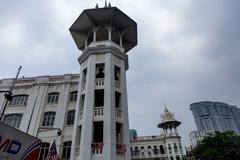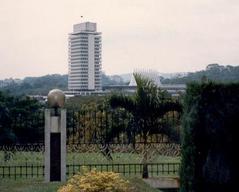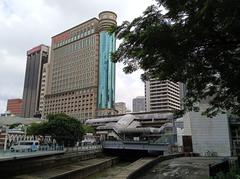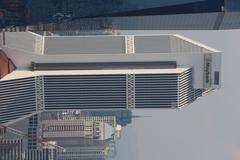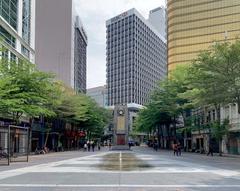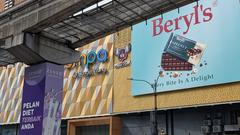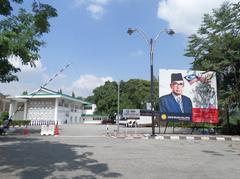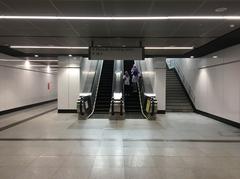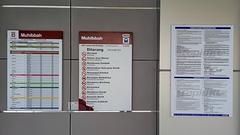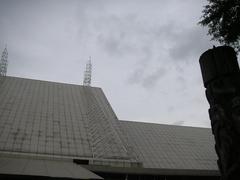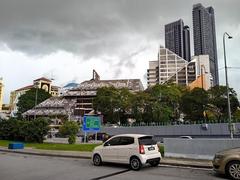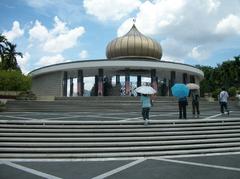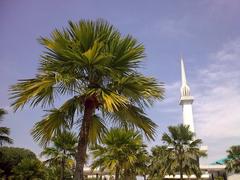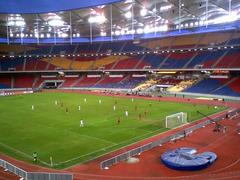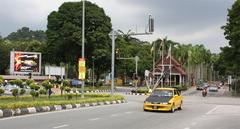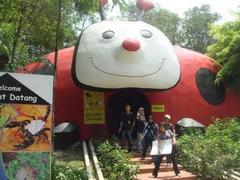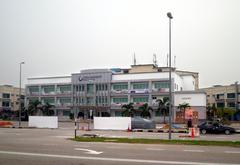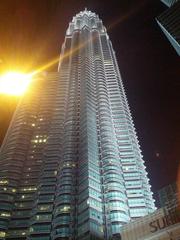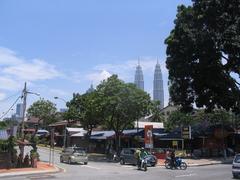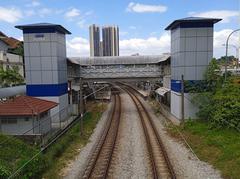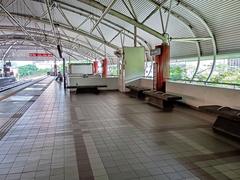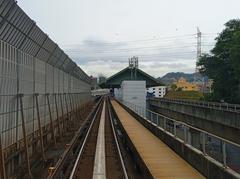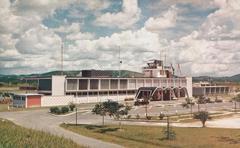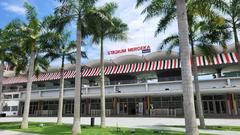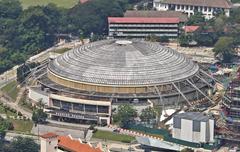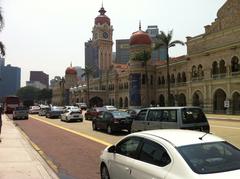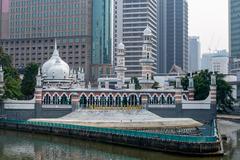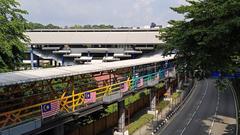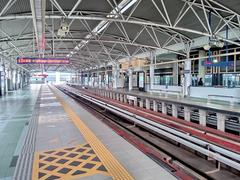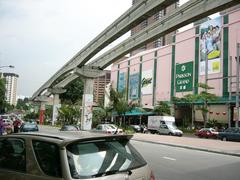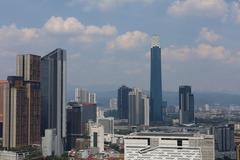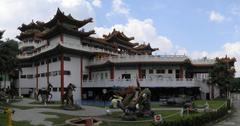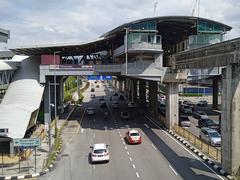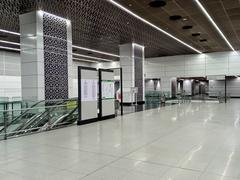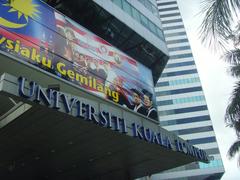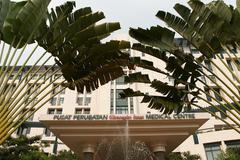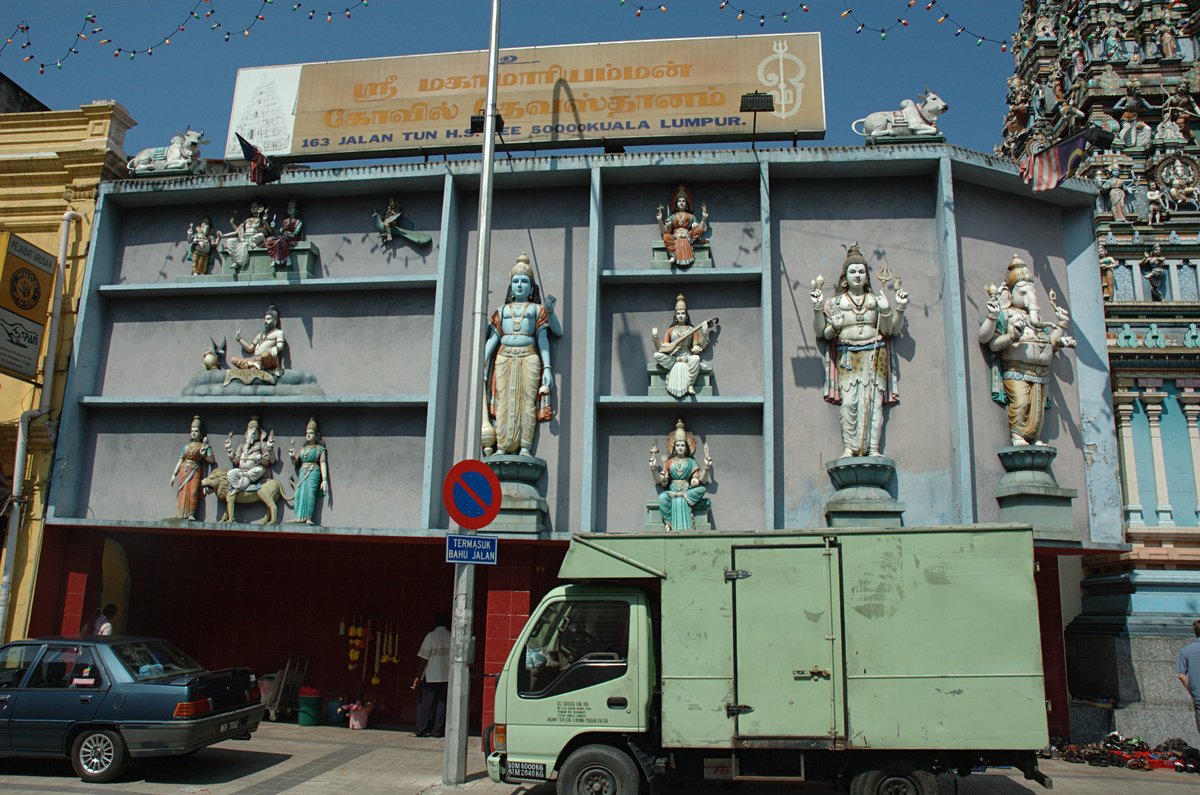
Sri Mahamariamman Temple Kuala Lumpur: Visiting Hours, Tickets, and Travel Guide
Date: 15/06/2025
Introduction
Located in the dynamic heart of Kuala Lumpur’s Chinatown, the Sri Mahamariamman Temple is the city’s oldest Hindu temple and a vibrant testament to Malaysia’s multicultural spirit. Founded in 1873 by K. Thamboosamy Pillai, this temple has grown from a private family shrine into a revered spiritual, cultural, and community hub for the Tamil Hindu population and beyond. With its striking Dravidian architecture—most notably the towering Raja Gopuram adorned with over 200 colorful sculptures—the temple is not only a place of worship but also a living museum of South Indian artistry and Malaysian heritage.
Welcoming visitors daily and offering free admission, the temple invites everyone to witness traditional Hindu rituals, admire intricate architecture, and experience major festivals like Thaipusam and Deepavali. Its central location—just steps from the Pasar Seni LRT station—makes it easily accessible, while nearby attractions such as Central Market and Petaling Street enrich the cultural experience. Whether seeking spiritual solace or a deeper understanding of Malaysia’s diverse history, the Sri Mahamariamman Temple is a must-visit Kuala Lumpur landmark (sakalam.org; klia2.info; mykualalumpurpass.com).
Historical Background
Origins and Early Development
The temple’s origins date back to 1873 when K. Thamboosamy Pillai, a prominent Tamil leader and philanthropist, established it as a private sanctuary for his family and close associates. At a time when Kuala Lumpur was a nascent tin mining settlement, the temple provided spiritual sustenance and a sense of community for the early Tamil diaspora (sakalam.org).
Opening to the Public and Institutionalization
In 1920, the temple transitioned from a private shrine to a public place of worship, overseen by a Board of Trustees. This marked its emergence as a central religious institution for the city’s Hindu community, responsible for organizing religious events, cultural celebrations, and social services (sakalam.org).
Architectural Evolution
The temple’s most iconic feature—the 23.5-meter (75-foot) Raja Gopuram—was completed in 1969. Crafted by skilled artisans from southern India, the gopuram is decorated with 228 vibrantly painted sculptures of Hindu deities and mythological figures. The temple’s design follows Dravidian architectural principles, with Italian and Spanish tiles, gold motifs, and precious stones contributing to its grandeur (mykualalumpurpass.com; wonderfulmalaysia.com).
Cultural and Social Significance
Primarily dedicated to Goddess Mariamman—venerated as a protector against illness—the temple also houses shrines for Lord Ganesha, Lord Muruga, and Goddess Lakshmi. It plays a central role in major festivals such as Thaipusam and Deepavali, and the annual Silver Chariot procession during Thaipusam is a city-wide highlight, drawing thousands of devotees and visitors (thrillophilia.com; sakalam.org).
Preservation and Modern Relevance
Recognized as a national heritage site, the temple is actively maintained, ensuring its continued role as a cultural and spiritual landmark in modern Malaysia. Its location near other places of worship—Buddhist, Taoist, and Islamic—makes it a symbol of Malaysia’s religious coexistence (klia2.info).
Religious and Cultural Significance
Central Role in the Hindu Community
The temple remains the focal point for the Tamil Hindu community in Kuala Lumpur. Beyond religious ceremonies, it serves as a center for cultural preservation, community gatherings, and charitable works (klia2.info; wanderon.in).
Dedication to Goddess Mariamman
Sri Mahamariamman is dedicated to the goddess Mariamman, a South Indian manifestation of Parvati who is especially revered for her protective and healing powers. The temple’s main sanctum features her idol, and additional shrines honor Lord Ganesha, Lord Murugan, and Goddess Lakshmi (thrillophilia.com).
Architectural Symbolism
The Dravidian-style gopuram serves as a symbolic gateway from the material world to the spiritual, with its vibrant statues narrating Hindu mythologies. Inside, the prayer halls are adorned with murals, gold motifs, and imported tiles, reflecting both religious devotion and artistic excellence (wonderfulmalaysia.com; malaysiavisa.ae).
Rituals, Festivals, and Processions
Daily Rituals
Priests perform daily pujas according to South Indian Agamic traditions. Offerings of flowers, fruits, and incense, accompanied by Vedic chants, create a serene and spiritual atmosphere (klia2.info).
Major Festivals
- Thaipusam: The annual Silver Chariot procession, carrying Lord Murugan’s statue to Batu Caves, is a focal event witnessed by thousands (thrillophilia.com).
- Deepavali: The temple is illuminated with oil lamps and colorful kolam, celebrating the Hindu festival of lights.
Interfaith and Multicultural Importance
Surrounded by Buddhist, Taoist, and Islamic religious sites, the temple exemplifies Kuala Lumpur’s harmonious multicultural environment and welcomes visitors from all backgrounds (wonderfulmalaysia.com).
Community and Charitable Functions
The temple organizes food distribution, scholarships, and disaster relief, upholding the Hindu principles of dharma and service (malaysiavisa.ae).
Visiting Information
Opening Hours
- Daily: 6:00 AM – 9:00 PM
- Hours may vary during major festivals; check ahead for updates.
Admission
- Entry: Free for all visitors
- Donations are welcome to support temple maintenance.
Dress Code and Etiquette
- Dress Modestly: Shoulders and knees covered; sarongs are available at the entrance.
- Shoes: Remove footwear before entering; shoe storage is provided.
- Behavior: Maintain quiet, respectful conduct; do not disturb ongoing rituals.
- Photography: Allowed in outer areas; restricted in the inner sanctum and during ceremonies.
Accessibility
- Public Transport: Near Pasar Seni LRT station; also accessible by bus and taxi.
- Parking: Limited street parking; public transport recommended.
- Wheelchair Access: Main precincts are accessible, but some steps are present.
Facilities
- Restrooms: Not available inside; use nearby facilities such as Central Market.
- Shops: Vendors sell garlands, incense, and souvenirs outside the temple.
Guided Tours
- Available upon request via the temple office or local tour operators; recommended for deeper insight into the temple’s history and rituals.
Architectural Highlights
The Gopuram (Gateway Tower)
Standing 23.5 meters high, the gopuram is adorned with hundreds of colorful statues depicting Hindu deities and mythological scenes—a visual narrative of South Indian spirituality and artistry (mykualalumpurpass.com).
Main Prayer Hall
Designed to symbolize the human body according to Dravidian tradition, the prayer hall features frescoes, gold-leaf detailing, and sacred geometric patterns. The main sanctum is the spiritual core, surrounded by subsidiary shrines.
The Silver Chariot
This 350 kg silver chariot, crafted in 1983, is paraded annually during Thaipusam. Its intricate reliefs and bells exemplify the temple’s ritual splendor (thrillophilia.com).
Special Events
- Thaipusam: Annual procession with the Silver Chariot to Batu Caves, usually in January or February.
- Deepavali: Celebrated with elaborate prayers, decorations, and community feasts.
Nearby Attractions
- Central Market: Heritage crafts and food (Central Market KL).
- Petaling Street (Chinatown): Street food, shopping, and local culture (Petaling Street Guide).
- Sultan Abdul Samad Building: Iconic colonial landmark.
- Kasturi Walk: Open-air market.
Practical Tips
- Visit early mornings or evenings for a peaceful experience.
- Dress appropriately and observe temple customs.
- Plan visits around festival dates for either quiet reflection or lively celebrations.
- Bring cash for donations and small purchases.
Frequently Asked Questions (FAQ)
Q: What are the temple’s opening hours?
A: Open daily from 6:00 AM to 9:00 PM; extended hours during festivals.
Q: Is there an entrance fee?
A: No, entry is free; donations are appreciated.
Q: Are guided tours available?
A: Yes, upon prior request via the temple office.
Q: Is the temple wheelchair accessible?
A: Main areas are accessible but some steps may require assistance.
Q: Can I take photos inside the temple?
A: Permitted in outer areas; restricted in the sanctum and during rituals.
Map and Virtual Tour
- Google Maps Location
- Virtual tours or photos may be available on local tourism websites.
Safety and Health Guidelines
- Keep valuables secure, especially during crowded events.
- Use hand sanitizer after touching communal surfaces.
- Follow any current health advisories (Ministry of Health Malaysia).
Contact Information
- Temple Office: +60 3-2078 3467
- Official updates via Tourism Malaysia
Conclusion
The Sri Mahamariamman Temple is more than an architectural marvel—it’s a living repository of Malaysia’s multicultural heritage, spiritual traditions, and artistic excellence. With its welcoming atmosphere, rich history, vibrant festivals, and central location, the temple offers an unforgettable glimpse into Kuala Lumpur’s dynamic cultural mosaic. Whether you come to observe, participate, or simply marvel at its beauty, the temple promises a meaningful and memorable experience.
Sources and Further Reading
- sakalam.org
- klia2.info
- mykualalumpurpass.com
- Tourism Malaysia
- thrillophilia.com
- wonderfulmalaysia.com
- malaysiavisa.ae
- Wikipedia
- Central Market KL
- Petaling Street Guide
- Malaysia Meteorological Department
- Royal Malaysia Police
- Visit KL
For more travel insights and personalized guides, download the Audiala app and follow us for updates on Kuala Lumpur’s cultural highlights and visitor experiences.
